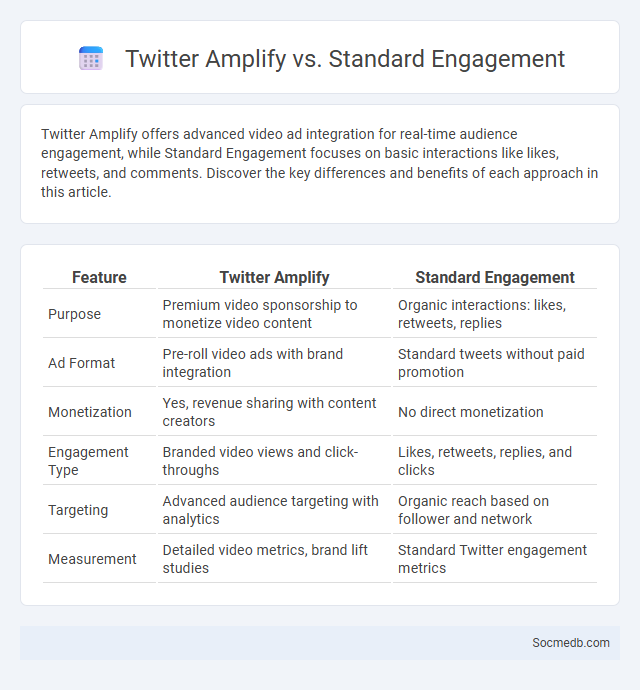
Photo illustration: Twitter Amplify vs Standard Engagement
Twitter Amplify offers advanced video ad integration for real-time audience engagement, while Standard Engagement focuses on basic interactions like likes, retweets, and comments. Discover the key differences and benefits of each approach in this article.
Table of Comparison
| Feature | Twitter Amplify | Standard Engagement |
|---|---|---|
| Purpose | Premium video sponsorship to monetize video content | Organic interactions: likes, retweets, replies |
| Ad Format | Pre-roll video ads with brand integration | Standard tweets without paid promotion |
| Monetization | Yes, revenue sharing with content creators | No direct monetization |
| Engagement Type | Branded video views and click-throughs | Likes, retweets, replies, and clicks |
| Targeting | Advanced audience targeting with analytics | Organic reach based on follower and network |
| Measurement | Detailed video metrics, brand lift studies | Standard Twitter engagement metrics |
Introduction to Twitter Engagement Models
Twitter engagement models analyze how users interact with content through likes, retweets, replies, and mentions to boost visibility and drive conversations. Understanding these models helps optimize Your content strategy by identifying patterns that increase follower interaction and community building. Leveraging metrics like engagement rate and audience demographics ensures targeted and effective social media campaigns on Twitter.
What Is Twitter Amplify?
Twitter Amplify is a powerful advertising solution that allows brands to associate their ads with premium video content from leading publishers, enhancing reach and engagement. By leveraging real-time video content, Your campaigns gain visibility among highly engaged audiences, driving higher impact and brand affinity. This program enables targeted, contextually relevant ad placements that boost message resonance and campaign performance on Twitter.
Defining Standard Engagement on Twitter
Standard engagement on Twitter typically includes metrics such as likes, retweets, replies, and mentions that measure user interaction with your content. Tracking these interactions helps you understand your audience's preferences and increase your content's reach effectively. Optimizing your tweets to encourage these standard engagement actions improves your overall social media presence and amplifies your brand's visibility.
Understanding Amplification in Twitter Marketing
Understanding amplification in Twitter marketing involves analyzing how your content spreads through retweets, likes, and mentions, increasing its reach beyond your immediate followers. Effective use of hashtags, engaging visuals, and timely interactions enhance the likelihood of your tweets being shared widely, boosting brand visibility. Measuring key metrics like engagement rate and reach helps you refine your strategy to maximize amplification and achieve your marketing goals.
Key Differences: Amplify vs Standard Engagement
Amplify engagement on social media drives higher visibility by leveraging sponsored content and targeted ads, ensuring messages reach broader and more specific audiences efficiently. Standard engagement relies on organic interactions such as likes, comments, and shares, reflecting genuine user interest but often limited by algorithmic reach. Brands prioritize Amplify strategies for rapid growth and precise targeting, while Standard engagement builds authentic community connections and long-term loyalty.
Advantages of Using Twitter Amplify
Twitter Amplify boosts real-time audience engagement by integrating high-quality video clips within live broadcasts, increasing viewer reach and retention. Brands leveraging Amplify experience enhanced ad targeting and measurement capabilities, resulting in higher conversion rates and ROI. The platform's ability to sync premium content with relevant conversations drives amplified brand visibility and consumer trust.
When to Use Standard Engagement Strategies
Standard engagement strategies on social media are most effective during product launches, promotional campaigns, and content that aims to build brand awareness. These tactics include consistent posting, prompt responses to comments, and use of relatable hashtags to foster a community around the brand. Leveraging analytics to determine peak user activity times enhances engagement rates and overall campaign success.
Measuring Amplification Effectiveness
Measuring amplification effectiveness on social media involves analyzing key metrics such as reach, engagement rate, click-through rate (CTR), and share of voice to determine how well content spreads and resonates with target audiences. Tools like native platform analytics (Facebook Insights, Twitter Analytics) and third-party solutions (Hootsuite, Sprout Social) provide detailed reports on amplification performance, enabling brands to optimize their content strategies. Tracking conversions from amplified content offers insights into ROI and helps refine influencer partnerships and paid promotion tactics.
Choosing the Right Approach for Your Campaign
Selecting the right social media approach for your campaign involves analyzing target audience behavior, platform demographics, and engagement patterns. Emphasizing data-driven strategies such as A/B testing and content performance metrics maximizes reach and conversion rates. Tailoring content format and posting schedules to align with platform algorithms enhances visibility and brand interaction.
Future Trends in Twitter Advertising and Amplification
Twitter advertising is rapidly evolving with future trends emphasizing AI-driven personalization, increased integration of augmented reality (AR) ads, and enhanced real-time data analytics for precise audience targeting. Your campaigns will benefit from Twitter's advancements in conversational commerce, enabling seamless customer interactions and amplified brand engagement through automated chatbots and influencer partnerships. Leveraging these innovations will maximize your advertising ROI and elevate your social media presence.
 socmedb.com
socmedb.com